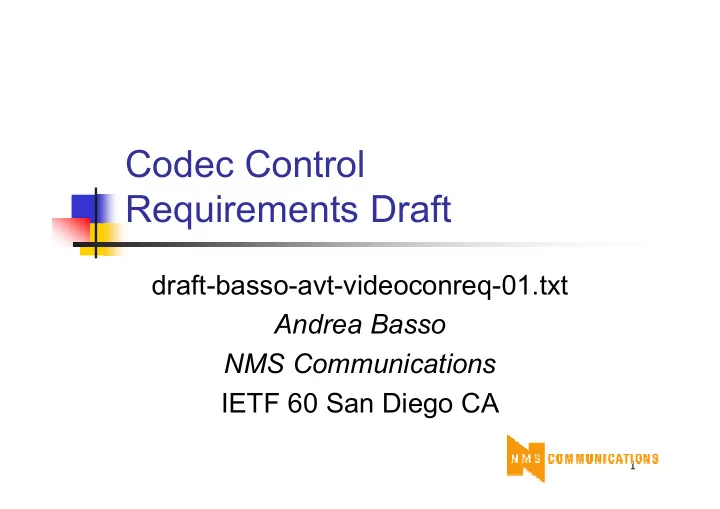

Codec Control Requirements Draft draft-basso-avt-videoconreq-01.txt Andrea Basso NMS Communications IETF 60 San Diego CA 1
Motivation A variety of video communication services such as video conferencing and video messaging rely on the capability of video encoders and decoders to respond to control commands. The list of commands and their transport are not currently standardized in IETF. 2
Use Cases RTP video mixer composing multiple encoded video sources into a single encoded video stream . (reference frame request) RTP video mixer receiving RTP video streams which dynamically selects one of the streams to be included in its output RTP stream. (reference frame request) Application that needs to signal to the remote encoder a request of change in the coding strategy . (spatiotemporal tradeoff request) Video mixer that switches its output stream to a new video source. (freeze frame and reference frame request) Video mixer that dynamically selects one of the received video streams to be sent out to participants and tries to provide the highest bit rate possible to all participants while minimizing stream transrating . (max rate request, actual rate as response) 3
Video Codec Control Commands VideoFreezePicture Freeze release sent in-band VideoFastUpdatePicture VideoTemporalSpatialTradeOff(index) RateRequest(MaxBitrate) Request new rate for rate matching (MCU): a new SDP in a RE-INVITE can be used Adapt to network conditions: out of scope As specific command to change the rate in mid call independently of network conditions RateNotify(MaximumBitRate) 4
General Requirements Reuse of existing protocols Maintain existing protocol integrity Avoid duplicating existing protocols Efficiency 5
Video Codec Control Requirements Reliable versus unreliable delivery Depends on the set of identified commands Capability description Express this capability in session description Relation with media Media stream and its control should be tight and uniquely identified. Independence from signaling Bi-directional transport Depends on the set of identified commands Extensibility Unicast and multicast support Unicast, Specific Source Multicast Interoperability with other protocols Timely delivery 6
Changes Comments addressed in –01 submission Added boilerplate text Sec. 3: Clarification of video coding terminology Sec. 5 :Removed videoFastUpdateGOB(firstGOB, numberOfGOBs) Sec. 6: Reference to IETF protocols only Harmonization with H.241 7
Section 3 Terminology clarified for picture types Intra Reference Intra Non-reference Non-Intra reference Non-Intra Non-reference Clarified concept of slices Harmonized to reflect characteristics of codecs as H.264 8
Section 5.2 Removed videoFastUpdateGOB(firstGOB, numberOfGOBs) Not used in practice Too specific to H.263 9
Sections 6.1, 6.2, 6.3 Reference to IETF protocols only Reuse of existing IETF protocols Avoid duplication of IETF protocols Maintain IETF protocol integrity 10
Comments after –01 submission 11
Section 5.2 Clarification of MaxRateNotify I.e Allow an MCU or a video processor (transcoder) element to configure efficiently the available media processing resources Addition of a command to explicitly request a mode 12
Section 7.4 Clarification: Relation with Signaling Codec control protocol should be usable independently from underling signaling Codec control protocol should not rely on any specific signaling protocol. Text may need clarification MUST -> SHOULD 13
Section 7.8 Clarification: Interoperability Why interoperability? How to define “interoperability” 14
Section 7.10 Timely Delivery of commands Cannot be ‘enforced’ MUST -> SHOULD 15
Next Steps Finalize the set of commands in this meeting Finalize the requirements in this meeting WG work item Start the protocol definition 16
Recommend
More recommend